Boost your triathlon game with these dynamic core exercises! From planks to mountain climbers, power up your core for enhanced stability, balance, and endurance. Dive into the journey of a stronger you!
Tag Archive for: triathlete
Kerrville, Texas, boasts a delectable culinary landscape that caters to all tastes and cravings. Indulge in a cozy and charming meal at Bridget’s Basket or savor the fine dining experience at Pinnacle Grill. For a true taste of the region, Hill Country Cafe offers comfort food with a local twist.
If you bought a 50-year-old Porsche 911 everyone would say you bought a classic car, but when athletes turn 50 people tend to think they become junk heaps.
The athletes themselves know that training at 50+ can be just as rewarding and fun as racing when you are younger and stronger. It just takes a different focus, and your training needs to be modified, to fit your older and more worn body.
Specificity, strength, speed, and rest become the most important part of maintaining a racing lifestyle for an athlete over 50.

Specificity
Specificity is training to fit your racing. It makes no sense to ride 100 miles if you are training for a 10-mile Sprint Tri, or swim 7 days a week when your swim is 500 yards. Your training needs to be focused to fit your goals and the races you choose. If your races are long, then long, slow miles are in order whereas shorter races will call for more intense workouts of shorter duration. Your body can usually handle intensity OR distance but not usually both at the same time.
Strength
Every triathlete should be doing 2-3 days of strength training a week. Triathlon has your body using muscles in a very limited range of motion for long periods of time. Strength training can keep your muscles balanced and help prevent injury. No need to focus on the physique of The Rock. Your strength training should be lower weight and higher reps. Leave the high weight and low reps to the muscle-bound mirror watchers at the gym.
Speed
Speed is often forgotten as athletes age. They tend to do lots of “Junk Miles” meaning they slog through a slow 20 mile ride or shuffle 10 miles on the run. Those can be helpful on easy days, but on the hard days, you need to bring intensity. Go to the track on your hard days and push your speed. Do some hard and fast 100’s in the pool, or try out fins. You only increase your speed by doing the activity at a higher pace. Keep in mind that your body cannot handle the same intensity as the younger athletes. Don’t try and keep up with the 30-year-olds at the track. 
Rest
Rest is the most underrated training tool that triathletes have yet it holds so much power. Getting to a workout after a miserable night’s sleep and then pushing yourself is a recipe for injury and no fun. You should try to get 7-8 hours of good solid sleep every night. If you get up at 4:30, to meet your running group, you need to be in bed by 9:00 or even 8:30. You can train yourself to go to be early. Getting your body to adjust to an early bedtime is just like any other training you do.
Racing and training over 50 can be incredibly rewarding. When you pass another 50+ athlete you always get a “hey” or head nod. They know what you are doing to still be active, and fast, and they appreciate it. It’s like joining a Porsche Club for classic cars only you have joined the club of Athletes Over 50. These club benefits are the most rewarding you will find.
Persistence can be your secret weapon.
Author Bio: Steve Mallett has been racing triathlons since 1984 and has completed over 120 races. He has completed many 50 mile running races and in 2019 completed the Rim to Rim to Rim in the Grand Canyon. He loves training with new and veteran athletes. Steve has the nickname Realtor Runner, is a former USA Triathlon coach, a Kerrville Triathlon Ambassador, and is a member of Team Zoot.
During training, you don’t have the luxury of aid stations like you do on race day. As if you needed another reason to love race day, hydration on course has always been a fan favorite. However, during training runs it is critical to stay properly hydrated. Make sure you carry hydration with you on your runs. If you’ve just started training make sure you follow these tips to keep your training running smoothly.
Try one of the options below to carry hydration on your next run. There are links below where you can order these items or you can visit our friends at Fleet Feet Austin!
 Handheld Bottle
Handheld Bottle
Using a handheld bottle on the run is an easy start to carrying hydration with you on your run. There are options to have a hard bottle or soft flask handheld. The harder bottle retains its shape and usually has more insulation. The soft flask is lighter and has the option to fit in a pocket when empty. The main con to a handheld is that one of your hands will be occupied by physically holding onto the bottle as you run.
Pro tip: It is a good idea to switch up which hand is holding the bottle during your run.
Water Vest or Backpack
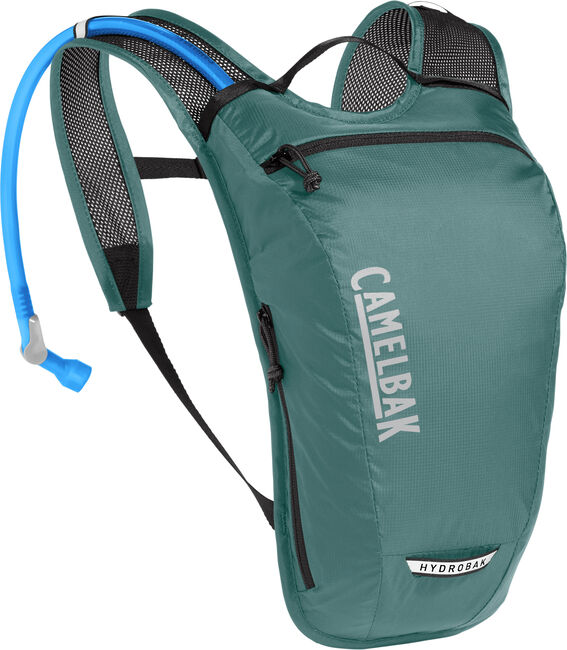
Needing to carry more water than what can fit in a handheld, or would like your hands to be free? A water vest or backpack is a great option. The weight of the water vest/ pack is distributed more evenly through the torso, which allows for a more symmetrical weight distribution while running. These options also have extra storage to include nutrition or your phone during your run.
When deciding between a vest or a backpack think of how you want it to fit and where you want your water storage at.
- Vest
- A hugging fit. It keeps things close to your body for a tighter fit that reduces bounce.
- Bottles in the front pockets and option for hydration bladder in the back.
- Backpack
- Fit is more relaxed.
- Bigger hydration bladder capacity. Some have options for a bottle in the front
Pro tip: Always be conscious of how a vest/pack rubs on the inside of your arms and neck/shoulder areas. Any bit of uncomfortable chafing will be multiplied by sweat and miles, so choose wisely. Try Body Glide anti-chafing cream!
Water Bottle Waist Belt 
If you want your hands free and don’t like the idea of carrying more weight through your torso a waist belt is worth a try. We like SPIbelt’s Distance Pro because the two, 8-ounce bottles can be placed anywhere on the elastic, allowing runners to maximize comfort. This running belt is built for durability and can keep up with your longest runs.
The belt pocket expands to hold larger smartphones, including the iPhone12 Pro Max, and Galaxy S20 Ultra, as well as keys, ID, and more. The elastic on this belt is 1.5″ wide, 50% broader than the Original SPIbelt.
Everyone’s preference is personal to what feels best for them to carry hydration. Test out what works best for you.
Biggest pro tip of all: Stay hydrated and have some fun!
One of the first decisions you’ll need to make when doing a triathlon is what type of suit to wear. Do you go for a one-piece or two-piece? There are pros and cons to both options, so it’s important to weigh up all the factors before making your decision. In this blog post, we’ll take a look at some of the key differences between one-piece and two-piece suits, as well as the advantages and disadvantages of each option. So read on if you want to find out more!
What is a Tri Suit?

A tri suit is a garment designed specifically for triathletes to be worn during the swim, bike, and run. They are made of a swimsuit-like material that dries quickly during your transition to the bike. They also make riding more comfortable with built-in pads that you won’t even notice during the run. It usually has built-in pockets so that you can carry some nutrition with you as well.
Most importantly, the suit allows for a total range of movement so you can wear the suit for the entire tri. A tri suit is an element of the basic triathlon gear you need, so keep reading to understand the differences between a one-piece and two-piece tri suit.
Two-Piece Tri Suit
A two-piece tri suit is a set of tri shorts and a tri top. Some athletes prefer a two-piece because they offer a few advantages.

For example, a two-piece is less likely to restrict your range of motion from being too tight on your shoulders and allow for natural movement. The two-piece suit also tends to feel cooler than a one-piece, due to the fact your mid-drift can be exposed.
A two-piece suit is also great for athletes who may require different-sized clothing for the upper and lower parts of their body. You can also usually find more options for the length of shorts. For women, you can find inseams from anywhere from 5 inch to 8 inch. Many prefer a shorter short length for short distances or training while a longer length can help prevent chaffing on longer distances.
One drawback is the two-piece can be less aerodynamic during the bike portion if the suit bunches up. Leaning too far forward on your bike can also cause the back of your tri top to rise up and lead to exposed skin. This is not ideal to protect your skin if you were to fall on the bike course or raise the risk of getting a sunburn.
One-Piece Tri-Suit
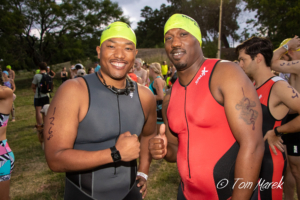
One-piece tri suits are more commonly preferred by most athletes for simplicity. A one-piece suit typically has some compression built-in, making the suit more aerodynamic for athletes who opt for a one-piece. Athletes also say there’s less chafing with a one-piece because there are fewer seams in the suit.
Many prefer a one-piece because you don’t have to worry about your shirt riding up or your shorts moving down exposing your mid-drift. Less shifting around = more time saved and a more comfortable experience.
Lastly, a one-piece suit is a better option if you will be wearing a wet suit during your race again because you don’t have to worry about anything moving where it shouldn’t when you go to peel off your wetsuit.

One drawback of a one-piece suit is the material the suit is made of can cause you to feel warmer throughout the race. This is important to take this into account depending on which tri distance you complete and what time of year your race takes place. You can look for a one piece that has a zipper for venting if needed. The other drawback is that you have to find a suit that works with your torso length, finding your “dream” suit can take longer with more trial and error.
At the end of the day, comfort is most important when choosing the best tri suit for you, if you decide to wear one at all. Hopefully, now you have the knowledge and tools you need to get yourself the perfect suit for your upcoming tri!
Adjusting your bike to the perfect saddle height is crucial in order to maximize comfort and payoff during your training rides for Kerrville Tri. Incorrect height leads to pain and discomfort during and after your ride. It can also prevent you from improving your performance on the bike. Learn the importance of correct saddle height, and how to adjust your bike to the perfect fit with these easy steps.
What is Saddle Height?
Saddle height is measured by the distance between the center of the pedal axle and the top of the saddle, or your bike seat. This is set by adjusting the seat post to your ideal height to balance your comfort and power on the bike. This height is arguably the single most important adjustment on your bicycle. Incorrect height can contribute to discomfort in the saddle, anterior and posterior knee pains, and ultimately limit how much power you produce.
How To Adjust Your Saddle Height
There are many ways you can approach finding your perfect saddle height. One of the best approaches is to establish it based on the rider’s individual ride characteristics and flexibility. You can follow the “heel to pedal method” before your next ride. This will get you in the ballpark.
- Stand next to your bike and raise the saddle to your hip to get an idea of where to start.
- Get on your bike, and place your heel on the pedal to determine if you will raise or lower your saddle.
- If you are having trouble making contact with your heel to your pedal – the seat is too high.
- If your knee is bent – it is too low.
- Put your bike on the trainer and adjust accordingly.
- Get back on your bike with your heel on the pedal and pedal backward to reach the six o’clock position.
- Your leg should be completely straight, without being overextended to achieve the correct saddle height.
Pro tip: Make very small adjustments during this process, then repeat until you have found the perfect height.
Ready to Ride
Once you find the proper height, use a piece of electrical tape around at the base of the post where it meets the seat clamp as a marker. Take a tape measure and record the measurements, in case you need to make very slight adjustments in the future.
Have a professional look at your bike every few years to achieve maximum comfort. After adjusting your bike to the perfect saddle height, make the first few rides short. Give it time! Your body may need a few sessions to adapt to your new height before you feel yourself improving on your cycling journey. How often do you check your saddle height? Let us know on Facebook and Twitter.
More than 1800 triathletes, the largest field in event history, registered for The Most Scenic Triathlon in Texas
Nearly 5000 triathletes and their friends and family traveled to Kerrville, Texas, for the 10th annual Kerrville Triathlon Festival. More than 1800 triathletes from 20 states, the largest field in event history, registered for the Most Scenic Triathlon in Texas. Participants gave their all during a picture-perfect weekend on a course highlighted by swimming in Nimitz Lake, cycling through the Texas Hill Country, and running along the Guadalupe River.
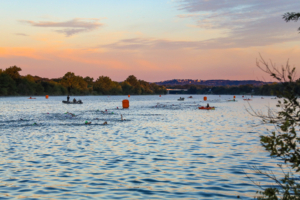
Stunning view of Nimitz Lake during the swim. Credit: Scott Flathouse
After crossing the finish line, participants were treated to fajitas and cold beer from Pint and Plow, snacks. May took advantage of an opportunity to recover in the refreshing waters of the Guadalupe River. Kerrville Tri also launched best pricing for 2022, which ends on Monday, October 4th.
“I couldn’t have asked for a better experience at my first quarter-distance triathlon,” said Kellie Dewveall, who became the first blind triathlete to complete the Quarter distance (4:17:47). “High Five Events was super accommodating which allowed me to feel more comfortable. And the participants and spectators overwhelmed me with their never-ending support!”
Something for everyone
Kerrville Tri offered distances and events for triathletes of all levels and abilities. The Rookie Sprint distance, aquabike, relay, and kids fun run took place on Saturday, September 25th. Quarter distance, quarter aquabike, half distance, half aquabike, and half relay took place on Sunday, September 26th. Participants picked up their packet at the Kerrville Triathlon Expo, which was free and open to the public. It took place on September 24-25 at the host hotel, Inn of the Hills Hotel. The national anthem was sung by Master Sergeant Brandon Addison on both days, including before he competed in the Rookie Sprint. Before each distance began, members of the Austin Tri Club led the pre-race warm-up, pumping up participants before their swim.
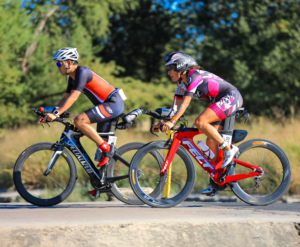
Cyclists cruise through the Texas Hill Country. Credit: Scott Flathouse
“This was my first Kerrville Tri and it was so well put together and by far the most seamless race I’ve ever done,” said Karina Wilson, who traveled from College Station and placed 2nd in the female 25-29 age group in the Rookie Sprint on Saturday (1:15:12) and volunteered with her fiance on Sunday. “We made a weekend out of this and really enjoyed the city of Kerrville. I love that Kerrville Tri offers different distances and events to make it inclusive for triathletes of all levels!”
Unforgettable race weekend
Ben Rawson (56:03), of Austin, Texas, won Saturday’s Rookie Sprint while Fernanda Bau (58:50), of Pflugerville, Texas, won the female division. Sunday’s winners and their times follow: Quarter – female winner, Allison Koch (2:24:28), male winner, Adrian Cameron (2:07:57); Half – female winner, Brandi Swicegood (4:54:29), male winner, Alex Sharp (4:28:12). Results for Saturday and Sunday are available.
“This was such an amazing day to enjoy this beautiful course aptly named The Most Scenic Triathlon in Texas,” said Swicegood, who’s coached by former professional triathlete Paul “Barny” Matthews under Julie Dibens Coaching. “The event was so well-organized with amazing views of the Texas Hill Country and spectator support seemingly everywhere!”

Swicegood (right) poses after becoming the female Half distance champ. Credit: Scott Flathouse
Participants received limited-edition 10th-anniversary swim floats, tri-blend shirts, reusable water bottles, belt buckle finisher medals, personalized race bibs, and Zone 3 silicone swim caps. A post-race meal of HEB fajitas, prepared by Jack and Adam’s Fredericksburg’s employees, awaited participants at the finish line festival. They’ll also get a free, personalized finish line video from FinisherPix to commemorate the 10th anniversary. Kerrville Tri is a USAT-sanctioned event. It provided professional timing and offered professional photography. A great volunteer crew, hundreds of supportive spectators, and an energetic finish line festival made race weekend memorable for everyone.
Big thank you
The Kerrville Triathlon would like to thank the City of Kerrville, Kerrville Fire Department, Kerrville Police Department, Kerr County Sheriff’s Department, Kerrville Convention and Visitors Bureau, and sponsors H-E-B, Peterson Health, Jack and Adam’s Fredericksburg, Pint and Plow Brewing Company, Grape Juice, Zone3, Peak Fitness, MO-RANCH, Hill Country Bicycle Works, Mamacita’s, and Gatorade.
Triathletes from 20 states are ready for the 10th-anniversary celebration
The Kerrville Triathlon Festival is ready to welcome the largest field in its 10-year history for triathlon’s return to the Texas Hill Country. Close to 1800 registrants from 20 states are bringing friends and families to the 10th -anniversary celebration. Kerrville Tri’s growth continues to showcase why it’s a true destination event. Race weekend features a two-day expo and eight different events, plus a free Kids Fun Run. Kerrville Triathlon is owned and produced by High Five Events. It’s scheduled to take place on September 25-26, in Kerrville, Texas. The final price increase occurs Tuesday, September 21st, at 11:59 p.m.
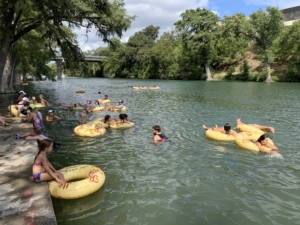
You can swim, bike, run, and float at Kerrville Tri!
“Kerrville Triathlon Festival is one of our family’s favorite weekends because there are two days worth of events for triathletes of all ability levels,” said Andrea Fisher, mother of four, Austin Triathlon Club President, and Ironman World Champion qualifier. “My girls, husband, and other Austin Tri Club members are racing on Saturday and supporting me and other triathletes during Sunday’s events. I’m excited to get out on the racecourse with all of my friends and my family, it’s been too long!”
10th-anniversary perks
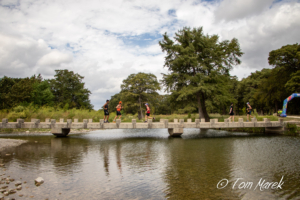
10 years of being The Most Scenic Triathlon in Texas.
Participants receive limited-edition 10th-anniversary swim floats, tri-blend shirts, reusable water bottles, belt buckle finisher medals, personalized race bibs, Zone 3 silicone swim caps, and a post-race meal. Kerrville Tri will also provide a free, personalized finish line video for all participants as part of its 10th anniversary. This video, valued at $19, was added to a list of perks already in place for the event. The popular destination triathlon is known for its scenic views and fun atmosphere.
“Kerrville Triathlon’s 10th anniversary is going to be special and we’re ready to celebrate with triathletes, family, and friends from 20 states,” said Stacy Keese, co-owner of High Five Events. “The event’s increased growth and popularity further highlight that it’s one of the top destination triathlons in the country.”
Something for everyone
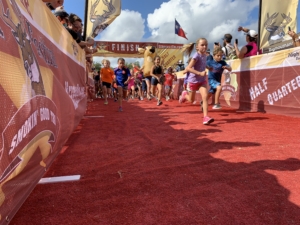
The free Kids Fun Run takes place on Saturday after the sprint distance.
Kerrville Tri offers distances and events for triathletes of all levels and abilities. The Rookie Sprint distance, aquabike, relay, and kids fun run take place on Saturday, September 25th. Quarter distance, quarter aquabike, half distance, half aquabike, and half relay will all happen on Sunday, September 26th. Participants can pick up their packet at the Kerrville Triathlon Expo, which is free and open to the public. It’ll take place on September 24-25 at Inn of the Hills Hotel.
Kerrville Tri is known as The Most Scenic Triathlon in Texas. It features a swim course in Nimitz Lake, bike course showcasing downtown Kerrville and the surrounding countryside, and run course along the Guadalupe River. Participants can also float in the Guadalupe river in their 10th-anniversary floats as part of the post-race festival. Kerrville Tri is a USAT-sanctioned event, provides professional timing, and offers professional photography. A great volunteer crew, hundreds of supportive spectators, and an energetic finish line festival make race weekend memorable for everyone involved.
Save time during your race with these transition tips
Transition is where all of your gear is set up for switching between sports. This can be a really chaotic place, but an organized transition area can save you time and help you achieve your goals. There are two transition areas (T1 and T2) at Kerrville Triathlon. There are also different gear bags for T1 and T2. This gear bag guide will help you get everything you need in the right spot! Review the weekend schedule to ensure you know when transition opens and closes for your race. Shoutout to Michelle Bonathan, Kerrville Tri Ambassador, for putting together these transition tips.
Setting up T1 for cycling
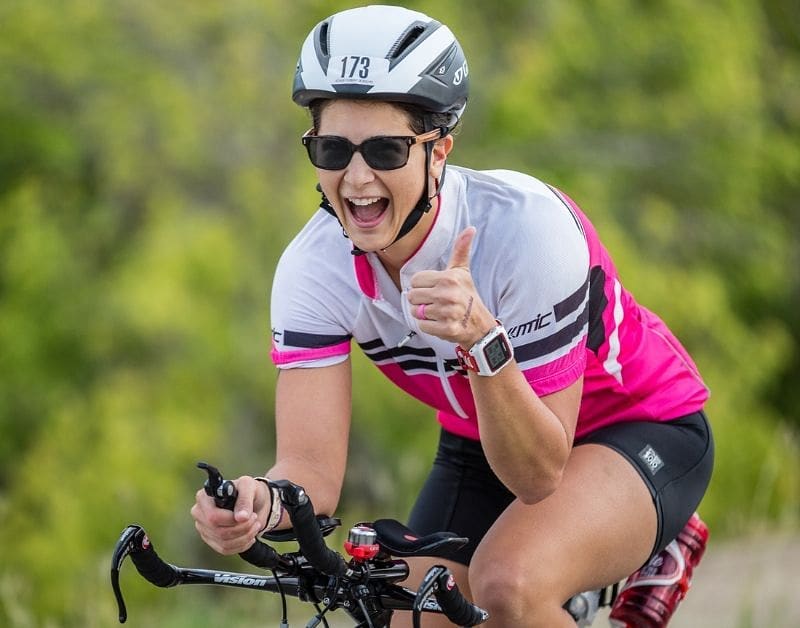
Properly set up T1 to save time and crush the bike ride! Credit Michelle Bonathan
This is where you will drop off your swim gear after the swim and get ready to bike. Your cycling essentials are your bike (packed with the water/nutrition), shoes, and helmet. Laying a small, bright-colored towel down can make it easier to spot your setup in transition after the swim. On the towel, have an area to stand on to dry/wipe your feet. Place your helmet and shoes close by and make sure they’re ready to slip on. Arrive early for bike check at T1 to increase the chances you get a good spot. USAT rules are that bikes should be racked by the saddle and the front wheel goes down on the side with your stuff.
The first of your three gear bags will be the Green “Morning Clothes Bag.” Place anything you’ve worn to the race site that you will not use during your race in this bag. Drop it off at the assigned box truck at T1.
Your “Bike Gear Bag” is red. You’ll put your swim gear (goggles, swim cap, wetsuit, towel) in the bag when you get out of the water. This bag will be delivered to T2 by awesome volunteers. Thank them as you head out with your bike!
Packing T2 for the run
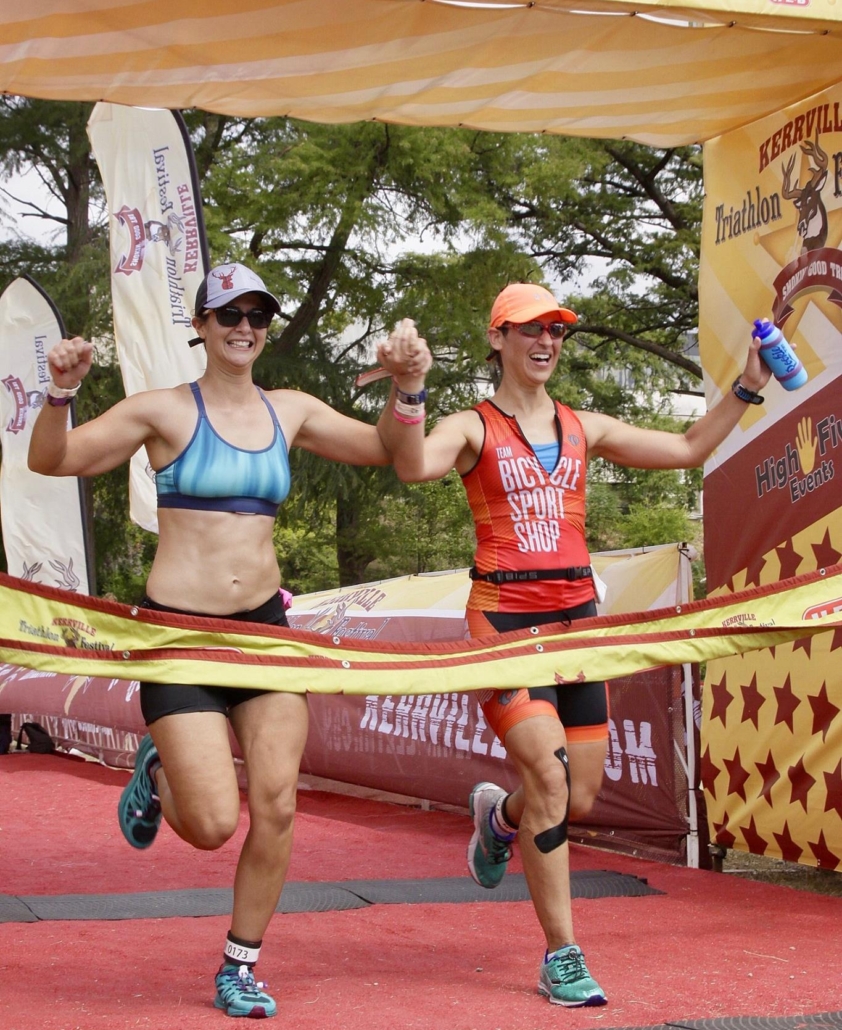
These transition tips will help you achieve your Kerrville Tri goals. Credit Michelle Bonathan
Your last bag is the Blue “Run Gear Bag.” This is for all your run gear when you get to T2. This bag will hang from a designated spot corresponding to your bib number. It must be dropped off before race day! The absolute essentials for this bag are your run shoes (if you don’t ride with them) and your race bib. You might also want some nutrition, a second bottle, or a hat.
Speed tips
- consider riding sockless, but don’t do this for the first time on race day
- have shoes open and ready to pull on with socks open and stuffed in each shoe
- consider getting a race belt to hold your bib and avoid safety pins (they can also hold your gels)
These transition tips will make your race weekend that much easier. Follow the weekend schedule and use the gear bag guide to make sure you’re doing everything correctly. Now you just need to be at the start line and swim! All your gear will be waiting for you when you need it once you properly set up your transition area on race day.
Ensure your new running shoes are broken in and race-day-ready
You have an upcoming triathlon and all your running shoes need to be retired or are on the verge. So of course you’re ready for a new pair. Or two! There’s plenty of advice that can help you find what’s right for you if you don’t know exactly what you want. They’ll take care of you. Don’t start running in them right away. You’ll need to break in your new running shoes, even if they’re the same version as your old pair. This is a vital step that can make your future runs more comfortable and reduce the chance of injury. Utilize the 3 tips below to properly break in your new running shoes. They’ll get you race-day-ready and you’ll be more comfortable on the run.
#1 – Take the walk, then run approach
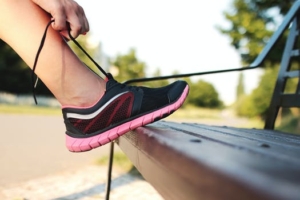
Give yourself plenty of time to break in your new shoes.
Don’t rush the breaking-in process. Your feet need time to adjust to your new running shoes and vice versa, your shoes have to adjust to your feet. Lace your shoes how you want them. Walk or lightly jog in them for a few days. If you’ve switched brands or tried a different style, add another day or two to ensure they’re the right fit. This gives your new running shoes and feet a chance to adjust to each other. During this time period, feel free to increase the amount of time spent walking or lightly jogging. If everything checks out then you’re good to increase your mileage! Ideally, you’ll break in your new running shoes within 4-7 days.
#2 – Wear running socks
Wear running socks during the break-in process so you get a precise idea of how everything feels. When walking or lightly jogging, make sure everything fits and nothing on the shoe rubs uncomfortably. Nobody wants to get blisters or have a part of the shoe rub your skin raw during a run. If your old shoes are wearing out, chances are some of your socks are too. Look for signs like the material getting thinner or holes in the toes.
#3 – Keep your old pair
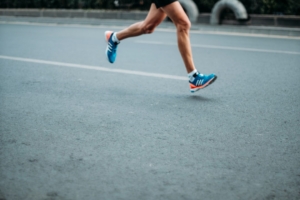
Increase your mileage once your shoes are broken in.
You know it’s time for new running shoes when you reach a certain mileage, experience lower-body pain, or the shoe doesn’t respond like it once did. But don’t get rid of your older shoes just yet, they might have some mileage left on them. Keep running in your current pair while you break in your new kicks. Once the new pair is ready to go, alternate what you wear during your runs if your older pair isn’t quite ready for retirement. If they have some more life they can extend the life of your new pair. Once the older shoes have hit their mileage give them a new life as yard work shoes and what you wear when walking your dog.
Once you get used to your new running shoes you’ll notice the difference! Your run will feel more comfortable, the shoe’s responsiveness will be evident, and the new cushioning will reduce the impact on your joints, muscles, and bones. Make sure you give yourself plenty of time to break in your new running shoes before race day. After all, you bought them for the event and you’ll want to show them off!
